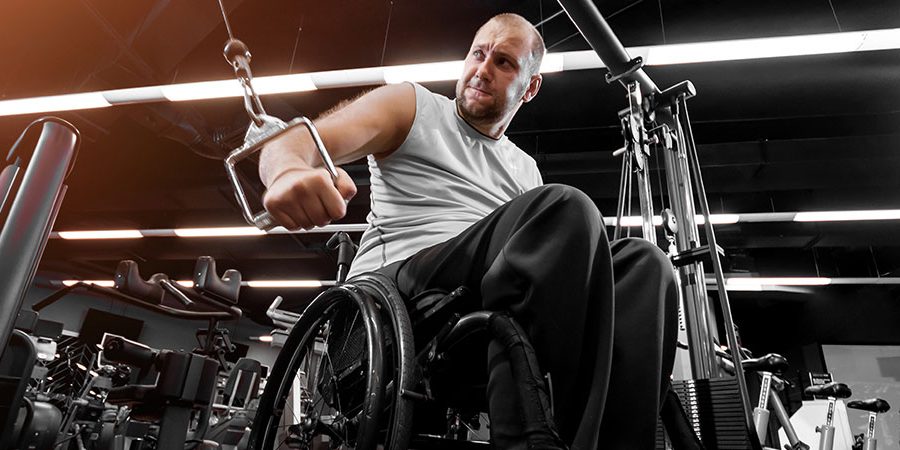In our position as fitness professionals, it’s essential we understand the unique needs and challenges faced by clients with disabilities to provide them with safe, effective, and inclusive exercise programmes. A recent study titled “Identifying and prioritising strategies to optimise community gym participation for young adults with cerebral palsy: an e-Delphi study” offers great insights and recommendations for improving gym participation for individuals with disabilities. This article discusses the details of the study, its results, and key considerations for working with these clients, along with suggestions for encouraging their participation in exercise.
The Study
The e-Delphi study, conducted by researchers Georgia McKenzie et al., aimed to identify and prioritise strategies to enhance physical activity participation in community gym settings for young adults with cerebral palsy (CP). The study engaged four stakeholder groups: young adults with CP, their families, gym staff or exercise professionals, and health professionals. Over three rounds, the participants identified and rated strategies based on their importance and ease of implementation.
The study highlighted several key areas for improvement to make gyms more accessible and inclusive for individuals with CP:
- Physical Environment: Accessibility of the gym environment was a top priority. Strategies included providing accessible parking, ensuring the gym layout accommodates mobility aids, and making accessibility information readily available on gym websites.
- Cost Barriers: Addressing the cost of gym memberships and associated expenses, such as transport, was identified as crucial. The study emphasised the need for public health funding and recognition of the benefits of gym exercise by disability funding bodies like the National Disability Insurance Scheme (NDIS) in Australia.
- Gym Staff Training: Training gym staff to adapt exercises for people with CP and incorporating disability-specific education into personal training and health professional courses were considered essential strategies. See our Exercise for Disabled Clients course here.
- Partnerships: Developing partnerships between sectors, such as health professionals and recreation facilities, to create pathways for gym participation was emphasised.
- Social Support: Providing individualised social support within the gym was important, although there was no consensus on who should provide this support.
Key Considerations
When working with clients who have disabilities, we must navigate a unique set of challenges and opportunities. It is crucial to approach each client with empathy, adaptability, and a comprehensive understanding of their specific needs. By focusing on individualised training programmes, ongoing education, creating an inclusive environment, effective communication, and collaboration with health professionals, we can significantly enhance the exercise experience for our clients. These key considerations, drawn from recent research and expert recommendations, provide a roadmap for fostering a supportive and empowering fitness environment for all individuals, regardless of their abilities.
- Adapting Training Programmes: Modify exercises and use adaptive equipment to meet the needs of clients with disabilities. Understanding each client’s unique capabilities and designing safe, effective workouts that promote physical and psychosocial wellbeing is crucial.
- Education and Training: Pursuing ongoing education focused on disability awareness and adaptive exercise techniques is vital. Certifications like the Exercise for Disabled Clients can provide the necessary skills to work effectively with disabled clients.
- Creating an Inclusive Environment: Fostering an inclusive and supportive gym atmosphere is key. This includes ensuring that facilities are accessible and that staff members are trained to handle the specific needs of disabled clients with sensitivity and respect.
- Collaboration with Health Professionals: Building partnerships with health professionals can enhance the support network for disabled clients, ensuring that exercise programmes align with broader health goals and medical advice.
- Effective Communication: Tailoring communication to meet the needs of each client is essential. We must be patient, empathetic, and capable of providing clear instructions to foster a positive and empowering training experience.

Encouraging Disabled Clients to Exercise
Encouraging clients with disabilities to engage in regular exercise can be a transformative experience, promoting both physical health and mental wellbeing. Again, we can play a pivotal role in this process by providing personalised support, creating an inclusive environment, and addressing any barriers to participation. Here are several strategies to effectively motivate and support disabled clients in their fitness journeys.
- Personalised Approach: Develop individualised exercise plans that align with the client’s goals, abilities, and health considerations. Assess their capabilities thoroughly and adapt exercises as needed.
- Promote the Benefits: Emphasise the physical and psychosocial benefits of regular exercise. Improved mental wellbeing, better circulation, reduced chronic pain, and enhanced quality of life are compelling reasons for clients to stay active.
- Build Confidence: Help clients build confidence in their physical abilities. Dispel myths that they are vulnerable and need to be sheltered by promoting the idea that their bodies are robust and can respond well to physical activity.
- Provide Social Support: Ensure that clients have access to social support within the gym, whether through one-on-one instruction, group classes, or support networks. Social interaction can significantly enhance motivation and adherence to exercise programmes.
- Address Accessibility and Cost Barriers: Work with gym management to improve physical accessibility and explore funding options to make gym memberships more affordable. This could involve advocating for public health funding or seeking support from disability funding bodies.
- Ongoing Education and Training for Staff: Advocate for and participate in ongoing training to stay informed about the best practices for working with disabled clients. This includes understanding how to adapt exercises, use adaptive equipment, and communicate effectively.
- Create a Welcoming Environment: Foster an inclusive culture in the gym where all clients, regardless of their abilities, feel welcome and supported. This involves using positive and respectful language, providing necessary accommodations, and promoting a sense of community.
The study offers valuable insights for those of us either working with or soon to be working with disabled clients. By addressing physical accessibility, cost barriers, gym staff training, and providing social support, we can create a more inclusive and supportive environment. Encouraging disabled clients to exercise requires a personalised approach, effective communication, and collaboration with health professionals. By implementing these strategies, we can help disabled clients achieve their fitness goals and improve their overall quality of life.
References
McKenzie, G., Willis, C., Yao, A., Munzel, F., Kennedy, R., & Shields, N. (2024). Identifying and prioritising strategies to optimise community gym participation for young adults with cerebral palsy: an e-Delphi study. Disability and Rehabilitation, 46(7), 1309-1317. DOI: Click here to review the full research article
Enhance Your Skills with Specialised Training
Are you ready to expand your expertise and make a meaningful impact on the lives of disabled clients? The Exercise for Disabled Clients course from TRAINFITNESS is designed to equip fitness professionals with the knowledge and skills necessary to create inclusive and effective exercise programmes. This course builds on the insights from recent studies, such as the e-Delphi study on optimising community gym participation for young adults with cerebral palsy, highlighting the importance of individualised training, accessibility, and professional collaboration. Enrol now to become a leader in inclusive fitness and transform your approach to training disabled clients.
Exercise for Disabled Clients Course – Distance Study
